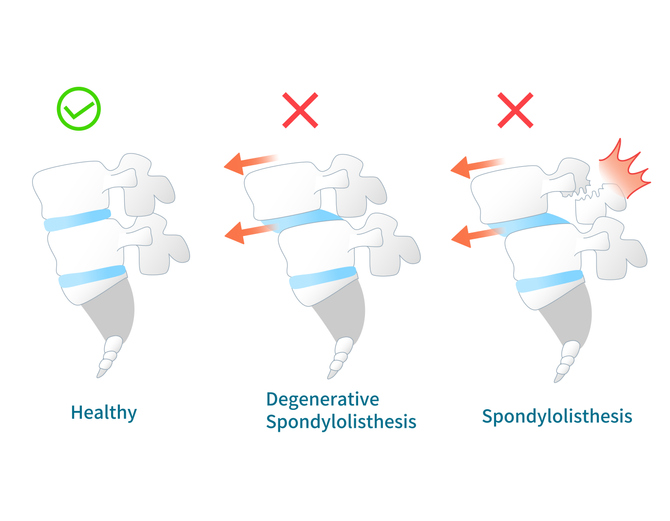Pain
Types of Spondylolisthesis

18 people found this helpful
Print
Share
Save
Spondylolisthesis is a medical condition that primarily affects the lower back (lumbar spine); however, it can also occur in the mid to upper back (thoracic spine) or neck (cervical spine). The body has 33 stacked vertebrae that form the foundation of the spine. Spondylolisthesis occurs when a vertebra slips forward (anterolisthesis) or backward (retrolisthesis) onto the vertebra underneath it, which may lead to nerve compression.
Each type of spondylolisthesis originates from a different cause. The most common types of spondylolisthesis include the following:
- Degenerative Spondylolisthesis
This is the most common type of spondylolisthesis and is typically the result of the aging process. Joints begin to wear as degenerative changes occur, arthritis becomes present, or discs lose water that provides a buffer between the vertebrae. This can result in a vertebra slipping out of place. Although it may occur in the cervical spine, degenerative spondylolisthesis typically occurs in the lumbar spine. - Isthmic Spondylolisthesis
As a result of spondylolysis, isthmic spondylolisthesis normally occurs due to a fracture in the pars interarticularis (a piece of bone that connects two vertebrae). A vertebra can slip forward, backward, or over the bone below. It is often the result of repetitive trauma in athletes. - Congenital/Dysplastic Spondylolisthesis
Also known as dysplastic spondylolisthesis, congenital spondylolisthesis is a birth defect of the facet joints, which allows the vertebrae to slip forward. It usually occurs in the lower joints at L5, the upper joints at S1, or both joints. It also causes the L5 joint to gradually slip as a person ages. This type of spondylolisthesis is more rare than other common types.
Less common types of spondylolisthesis include the following:
- Pathological Spondylolisthesis
This type of spondylolisthesis is rare and results from another condition, such as a tumor, osteoporosis, bone diseases, or certain types of cancer. As the bones become weak, slippage can occur, which can result in the backside portion of the vertebra becoming destroyed. - Traumatic Spondylolisthesis
Although traumatic spondylolisthesis is uncommon, it occurs when a traumatic injury causes a fracture or damage to the neural arch (the bony structure that surrounds the spinal cord). This allows the vertebrae to slip forward and can occur in both the cervical and lumbar spine. - Iatrogenic or Post-Surgical Spondylolisthesis
A previous spinal decompression surgery can cause spondylolisthesis. This occurs when a spine surgery is performed to remove a small portion of bone to give the nerve root more space or relieve pressure on the spinal cord. If the spine is not stabilized or too much bone is removed, the vertebrae can slip.
Additional source: Preferred Surgicenter














